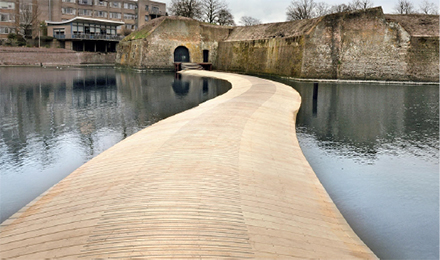A unique “floating” bridge spans Pielekenswater in Bergen op Zoom, Netherlands, with a design inspired by the work of Dutch military engineer Menno van Coehoorn, who built the 18th century Revelijn op den Zoom fortress in the same location. Source: Timberbiz
Ro Koster and Ad Kil of Bergen op Zoom-based RO&AD Architects designed the 80-metre floating pedestrian bridge to allow access to the 18th century fort’s entrance.
In former days, the Ravelijn was supplied from the city with small rowing boats so the bridge’s snake-like path mimics both the former route and the motion of the boats that once travelled from the city to the fortress. That is why the bridge snakes across the water to the fortress and why the architect opted to make the bridge float.
Its floating design also provides an additional advantage in winter: the bridge can be pulled to the side, so there can be ice-skating around the fortress. The deck of the bridge is convex to let the bridge blend in with the water and the surroundings; there is no reflection and it sits as close to the water as possible. The stairs at the jetty near the fortress can move up and down (and stay horizontal) with the water level.
The deck of the bridge, which is made entirely from Accsys’ Accoya wood, sits close to the water at Pielekenswater. The bridge is made completely to the principles of the Cradle to Cradle philosophy. Air-filled polyethylene pipes positioned underneath the timber surface help keep the bridge afloat, without requiring any additional structural framework.






